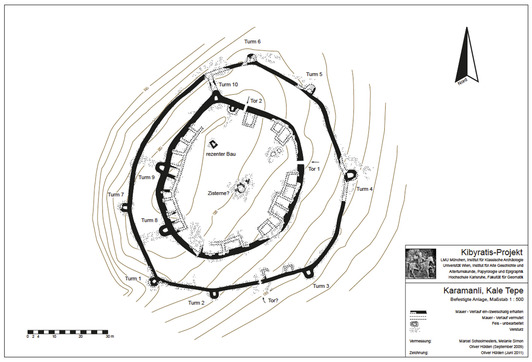Fortified Hilltop-site at Karamanlı
The town of Karamanlı is located close to the centre of our research area. In its immediate vicinity, on the top of a hill called Kale Tepe, we examined and mapped a small site surrounded by a double fortification wall erected using rubble stones and fortified with ten semi-circular towers.

Although ancient tombs have been discovered on the slopes and at the foot of Kale Tepe, the chronology of the site is rather unclear due to an almost complete absence of pottery sherds and other small finds, which makes a post-ancient date equally possible.
The situation becomes much more complicated by the possible assumption that the Turkish town of Karamanlı has overbuilt a Hellenistic-Roman village called Alassos, a name mentioned in several inscriptions from that period. So, the connection between Alassos, the fortified site on Kale Tepe, and a third site on a neighbouring hilltop featuring a monumental building probably of the (early?) Imperial period remains to be explained satisfactorily. For further information about Karamanlı see the current issue of Istanbuler Mitteilungen (Vol. 62, 2012).
While surveying the vicinity of Karamanlı, we also worked on two ‘rock sanctuaries’ situated close to Yuvalak and Tefenni. Their existence was known, but they have never been documented in detail. The one at Yuvalak was dedicated to the rider-god Herakles-Kakasbos and the other one was connected with the Dioskuroi. 14 new reliefs were discovered and apart from this we tried to understand the context of these ‘sanctuaries’. In one case at least, we made some progress in regard to this question thanks to the discovery of a (fortified?) village on a nearby hilltop which seems to have been inhabited during the Hellenistic and Roman periods. A first, more detailed discussion of the reliefs is made by K. B. Zimmer in the current issue of Istanbuler Mitteilungen (Vol. 62, 2012).

